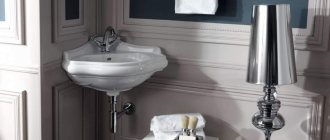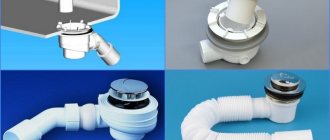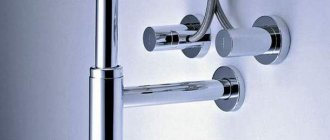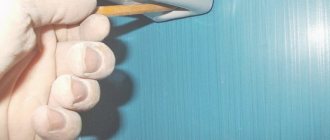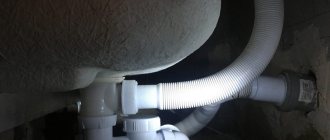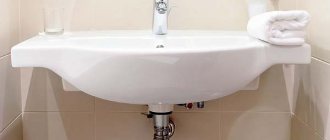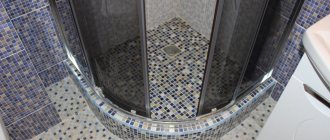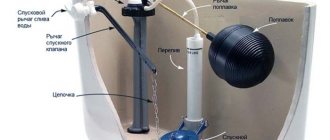Not a single apartment has a bathroom or kitchen without a sink. This element is very important for maintaining normal life. And in order for this device to serve you as long as possible, it requires proper attention.
The most important element of each sink is a detail such as a siphon. The sink siphon serves for proper drainage of water, to protect against flooding and against unpleasant odors.
In the photo of the sink siphon design you can see that this part always contains some part of clean water. This water plug protects against the penetration of unpleasant odors from the sewer.
Structure
A siphon is a metal or plastic structure that includes a reservoir and several pipes. One connects to the sink drain, the other to the sewer. It is in them that water flows when we wash our faces or wash dishes. Initially, the liquid from the sink enters the siphon, and from it through a curved pipe into the common sewer riser. A metal mesh located at the base of the device, on the sink opening, acts as a fine-mesh filter, protecting the system from blockages.
The curvature of the siphon ensures that a certain volume of liquid is retained, forming a water seal that prevents sewer odors from entering the house.
The purchased siphon kit usually includes a body, inlet and outlet pipes, metal mesh, linings and other consumables. Experts recommend purchasing models equipped with an overflow, which helps avoid flooding.
Rating of quality shower siphons
viega Tempoplex 6956EX 364 786
One of the best classical type siphons. Made from plastic and stainless steel. Therefore, the products will retain their original properties even after several years of active use. Connection diameter – 50 mm. The kit includes a siphon and a water seal.
The average price is 1,600 rubles.
viega Tempoplex 6956EX 364 786
Advantages:
- High service life;
- Easy installation;
- High quality water seal.
Flaws:
- Price.
AlcaPLAST A491CR
A good option that is suitable for installation under a shower tray. Made from plastic and polypropylene. Thanks to the smooth inner walls, debris will not linger inside and will not form a blockage. The appearance of the product is classic.
The average price is 923 rubles.
AlcaPLAST A491CR
Advantages:
- Efficiency;
- Easy installation;
- Price;
- Drains water well.
Flaws:
- Not detected.
Unicorn G410H
A budget siphon that is suitable for placement in a shower tray. The product is made of high-quality elements that will last for decades and will not break due to frequent use. Connection diameter – 65 mm, drain – 40 mm.
The average price is 445 rubles.
Siphon Unicorn G410H
Advantages:
- High service life;
- Warranty 12 years;
- Optimal price;
- Made from quality materials.
Flaws:
- Not detected.
Pipe siphon
Pipe is a popular option for a ceramic bathroom sink. It is not worth installing it in the kitchen, since it is more difficult to clean than other devices. These models are compact in size and attractive in design. The water seal is formed due to the curvature of the pipe. The lower leg of the device is usually removable. It will have to be dismantled to clean it.
The disadvantages of such a siphon include the following points:
- A shallow water seal, due to which the liquid evaporates quite quickly, and if the sink is rarely used, an unpleasant odor may appear in the room.
- The rigid design requires careful sizing: the siphon outlet must be located so that it can be connected to the sewer; installation is only permissible on standard drainage pipes.
USEFUL INFORMATION: How to make forced ventilation in the bathroom
What is important to consider when choosing?
Before purchasing a siphon, a person needs to pay attention to finding the optimal pipe diameter. It is best to install wide products, because the user will spend less time cleaning and will also increase service life.
The help of a plumber will not be superfluous. Not all people can understand plumbing systems, so when buying a siphon you should contact a familiar plumber or simply hire an independent expert who will help you choose the best product at a low price. It is worth paying attention to the gasket material; it is preferable to use rubber products, as they are more durable than plastic ones.
Bottle
Bottle siphon is the most popular type. Its design evokes associations with a flask or bottle, hence the name. The exhaust pipe can be either rigid or flexible corrugated.
Advantages of bottle devices:
- The siphon design allows you to effortlessly dismantle its most clogged part.
- This model is easy to maintain.
- The bottle drain does not need to be replaced for a long period of time.
- There is always water in the water seal, so the apartment is reliably protected from sewer smell.
- If small things get into the drain, they can be easily removed by unscrewing the flask.
The bottle version has some disadvantages: it accumulates contaminants in the drain container (hair, threads, grease), and is also more prone to leakage than other varieties due to the larger number of connections.
Types of hydraulic valves for sewerage
When classifying these devices, it is necessary to take into account, first of all, the design features. Based on this, all water seals can be divided into 6 types.
Knee siphons
Installation of a knee siphon for a sink
First on our list are pipe (elbow) siphons. In appearance, they are a pipe bent in the shape of the letter U. For the manufacture of pipe siphons, a polymer material is used - polypropylene.
Knee hydraulic valves are the most durable, capable of withstanding the highest possible water pressure in the system. They are most often installed in places where plumbing drains, in particular toilets and bathtubs. Often in such situations, one device is not enough, and therefore 2 siphons are installed at once.
Knee water seals can have a one-piece or collapsible design. If in the first case, if the device breaks down, you will have to dismantle it and replace it with a new one, then in the second case it becomes possible to repair the siphon with your own hands. The equipment is fixed using plastic clamps or special nuts.
An S-shaped siphon under a sink is installed quite rarely
S-shaped water seals operate on the same principle. They are used quite rarely when it is important to provide a more secure lock. There are also modifications equipped with an inlet for connecting the drain hose of a dishwasher or washing machine.
You can clear the knee siphons from blockages using a flexible plumbing cable or by dismantling the product.
Bottle water seals
Bottle siphons are also widely used to organize drainage under the sink. Every time you wash dishes, pieces of food enter the sewer system along with wastewater, leading to the formation of a garbage plug. Hydraulic bottle-type seals retain food waste, keeping the sewage system in working order. In addition, they perfectly perform their main function - they do not allow odors into the room.
Bottle siphon design under the sink
The design of a bottle siphon is quite simple and consists of a pipe onto which a container is additionally attached - the so-called bottle. Despite the fact that all parts of the product are made exclusively of polypropylene, their connections are not as reliable and cannot withstand the same high pressure as knee-type hydraulic valves. In this regard, bottle siphons, as a rule, are not used for installation in a bathroom or toilet, but are placed only under kitchen sinks.
Despite some disadvantages in terms of the increased likelihood of leaks, such hydraulic valves also have clear advantages:
- The procedure for clearing a sewer blockage is simplified: just remove the “bottle” by unscrewing the cap nut and clear it of accumulated debris;
- Objects that accidentally fall into the drain are also retained inside the siphon, and at the same time they can be easily removed from there without completely disassembling the structure.
Double turn siphons
Double-turn hydraulic valves are very similar to knee-type devices, but have a more complex configuration. Most of them are equipped with a filter grid and an inspection hole for cleaning the system.
In terms of reliability, double-turn siphons are better than bottle siphons: the likelihood of leaks in them is minimal. If previously water seals of this type were made of cast iron, now it has been replaced by no less durable and strong polypropylene. There are also chrome-plated models with similar technical characteristics.
Corrugated siphons
In terms of a number of indicators, corrugated sewer water seals are not inferior to any other of the above options. Their design is quite plastic and flexible, which allows installation even in small rooms without problems. One end of the corrugated pipe is connected to the drain, and the other to the sewer outlet.
Despite all their advantages, water seals of this type have one significant drawback: household waste gets stuck on the ribbed walls of the pipe, grease accumulates, and debris settles. In this regard, when installing a corrugated siphon, it is recommended to additionally install filtering equipment.
Monitor the condition of the corrugation and do not forget to periodically clean the device using available folk remedies. Otherwise, the siphon will not last long: it will lose its elasticity and strength. In addition, cracks may appear at the folds, which will lead to leakage.
Siphons with overflow
Installing water seals with overflow allows you to prevent flooding of the apartment in the event that one of the household members leaves and forgets to turn off the water tap. Such a siphon has an additional pipe to drain water into the sewer when it reaches a certain level in the sink.
Siphon design with overflow
The principle of operation of a siphon with an overflow is well known to everyone, since absolutely all bathtubs are equipped with a similar system. Although nowadays few people leave the water open for a long time, because almost everyone has water meters installed in their apartment.
When choosing, you should pay attention first of all to the throughput of the device. If the water does not have time to drain through the overflow, then such a hydraulic seal will simply be useless.
The most durable and expensive models are metal. It is better to entrust their installation to a specialist, while plastic siphons can be installed independently without much difficulty.
Dry seal design
Devices with a dry shutter can be divided into a separate group. They work similarly to a regular nipple and consist of a pipe with a check valve inside. Water entering the drain cannot flow back, and the smell from the sewer will also not penetrate into the room even if the communications dry out with infrequent use.
Dry seals are divided into the following types:
- pendulum, blocking the pipe almost instantly after the passage of water;
- membrane, closing the hole after draining the liquid into the sewer with an elastic membrane;
- float valves, working on the principle of fittings for flush tanks.
Such devices should not be used in kitchen sinks, since grease and food residues when washing dishes increase the likelihood of clogs.
Corrugated
This device is easy to install and consists of an outlet and a curved corrugated pipe.
Advantages of using a siphon for a corrugated sink:
- Can be connected to sinks and sewer risers even if their location is non-standard.
- Easy to install and affordable.
- The bend for the water seal is formed by the installer himself.
- Due to the absence of connections, the possibility of leakage is virtually eliminated.
- Regardless of the distance separating the sink and the floor, high-quality drainage will be ensured.
Like bottle drains, corrugated drains have their drawbacks:
- due to the unevenness of the inner surface, deposits of debris and dirt quickly form on it;
- hot water negatively affects the strength of corrugated pipes.
Rating of the best siphon models for the kitchen
VIRPlast Mini Elite
An excellent model designed for installation under the sink. A bottle type design is used. For convenience, height adjustment is provided, so a person can independently determine the value of the device. Connection diameter – 50, 40 mm. It is made of high-quality plastic, which shows high resistance to mechanical stress.
Sold at a price of 265 rubles.
VIRPlast Mini Elite
Advantages:
- Efficiency;
- Does not allow sewer odors to pass through;
- Easy installation;
- Durability.
Flaws:
- Not detected.
WIRQUIN Espace
A more expensive model that is suitable for placement under the sink. Made from durable materials that can withstand high pressure and do not deteriorate over time. The connection diameter is 40 mm. The water seal prevents coarse dirt particles from entering the sewer and also does not spread odors. For easier maintenance, a quick-release system is provided.
The average price is 1,190 rubles.
WIRQUIN Espace
Advantages:
- Saves space under the sink;
- Good flexibility;
- Universal use;
- Long service life.
Flaws:
- Price.
viega 5755 366 681
A beautiful bottle-type siphon, which is designed to be placed under the sink. There is a height adjustment, which allows you to adjust the equipment to specific dimensions. In addition to the siphon and water seal, the package includes a plug, socket, pipe, etc. This makes installation much easier. The connection diameter is 32 mm. Sold in silver color.
The average price is 1,500 rubles.
viega 5755 366 681
Advantages:
- Reliability;
- Durability;
- Easy installation;
- Aesthetic appearance;
- Shines.
Flaws:
- Not found.
McALPINE MRSK4
A budget option that copes with its task 100% and minimizes the chance of congestion. It is made of plastic, the design of the equipment is pipe (knee), which is suitable for most sinks. The declared service life is 3600 days.
The average price is 399 rubles.
McALPINE MRSK4
Advantages:
- Efficiency;
- Odors do not leak;
- 10 years of service;
- Universal connection diameter.
Flaws:
- Not found.
Flat siphon
A type of bottle device. The main difference is the compact size and flat flask. It is used in cases where there is simply no space for a standard product, for example when installing a sink above a washing machine.
Advantages of a flat siphon:
- Due to its compactness, it can be installed in the most difficult to reach places.
- Cleans up just as easily as a regular bottle model.
- Allows rational use of the space under the washbasin, for example for installing a household appliance or cabinet.
USEFUL INFORMATION: Bathroom design in a classic style: examples and photos
Popular manufacturers
The siphon production market is quite extensive. Therefore, you can consider purchasing both domestic and foreign brands. We will highlight the most famous brands that have proven themselves among specialists.
Among the foreign companies I would like to highlight: Viega (Germany), Geberit (Switzerland) and Jimten (Spain).
Russian brands producing siphons: Aniplast, VirPlast, Orio and Aquant. Unlike foreign companies, domestic manufacturers are much cheaper, but the quality is not inferior to foreign ones!
Additional functional elements
Siphons installed under the sink may have the following accessories:
- Drain-overflow. If the washbasin is equipped with a second top drain, a siphon equipped with an additional pipe (overflow) is installed under it. This will avoid accidental flooding.
- Bottom valve. A mechanism installed in the drain hole instead of a grate and acting as a plug.
- Additional side fitting for connecting household appliances (washing machine or dishwasher).
- Duplicate branch. It has a special siphon designed for sinks with two bowls. We select a drain for them with the required number of outlets. This is exactly the device shown in the photo below.
How to assemble a sink siphon
Replacing an old siphon is not a problem even for people who are far from plumbing. The main thing is to follow the sequence of actions and follow the recommendations of specialists.
We remove the old one
You will need a minimum set of tools, or rather a large screwdriver. Before starting work, place a basin or other container under the siphon, as water may pour out after removing the flask.
Holding the flask from below, use a screwdriver to unscrew the screw located in the center of the drain grate in the sink. After successfully completing the task, it is enough to disconnect the drain pipe from the sewer. You've done it, the siphon has been removed.
Assembling a siphon for a sink
Please note that when assembling the sink siphon there is no need to use sealant and silicone grease. The parts must fit tightly together without third-party products or materials. The kit should include all components necessary to install the water seal, including rubber gaskets, nuts, screws and instructions.
Assembly takes place in six stages:
- Arrange the parts in the order in which they should be attached according to the instructions. This must be done in order to check the completeness and plan further actions.
- In the case of installing a bottle siphon, the flask should first be assembled. To do this, you will need to install the rubber gasket from the kit and connect the two parts of the tank.
- Before connecting to the flask pipe, a plastic nut is put on the corrugation, after which a cone-shaped gasket is installed on the pipe. The thin edge should be on the bulb side.
- Connect the corrugation and the flask. Please note that the cone-shaped gasket must ensure a tight seal between these two elements.
- Tighten the nut to make the structure more durable.
- Place the nut on the neck pipe, and then the gasket, placing it with the tip down.
The MasterProf company offers its customers siphons under the UNICORN brand. The use of these siphons will allow you to avoid most of the difficulties during installation due to several points: the siphon bottle is supplied already assembled and most of the gaskets are integrated into the siphon body. You no longer need to guess which gasket goes where.
Installation of a siphon for a sink
Install the siphon neck (pipe) under the sink, having previously placed a gasket on its upper expanded part. At the same time, install another rubber gasket on the drain hole, then secure the metal grill and screw in the metal screw.
Important: A plastic nut is placed on the lower part of the neck, after which the gasket is installed. The thinner edge of the gasket should be on the tank side. After completing these steps, you can begin installing the previously assembled water seal structure. Fix it on both sides: connect one end to the neck, and the other to the sewer pipe.
Initially, you need to tighten the plastic nut, which is located at the top of the plumbing fixture. Please note that in this case the neck should be lowered quite far into the flask. Then seal the joint between the corrugation and the sewer pipe. As a seal, you can choose a simple rubber coupling, which will not allow drainage to penetrate beyond the pipe.
Possible materials of manufacture
Materials used to create siphons:
- Metal. The products are distinguished by their decorative appeal and increased strength, but over time they can be subject to corrosion and oxidation. They are usually made of brass, less often - of bronze, copper, stainless steel. The most common models are chrome plated. The main disadvantage is the difficulty in selecting the size, because shortening a metal pipe will not be easy.
Chrome-plated products are chosen for wall-hung and countertop sinks. Being visible, they not only do not spoil the design of the washbasin, but also complement it favorably.
- Plastic. Due to their affordable price and good performance, plastic products are in great demand and popularity. They are lightweight, simple in design, and resistant to household chemicals. In the connecting nodes, the plastic siphon is equipped with rubber seals, which increases the service life of the product and its tightness. The product range of many manufacturers includes models with a special antibacterial coating of the internal cavity, which prevents the settling of grease and dirt and reduces the rate of clogging.
Materials: plastic or metal ↑
Siphons, depending on the material from which they are made, are divided into two types: plastic and metal.
- Plastic. The cheapest siphons are polyethylene; as a rule, they have a simple design, mainly pipe, with a small number of connections. But polypropylene is used more often; parts made from it are more rigid, hold their shape better, and have more reliable connections. Polymer siphons of complex configuration are made from this plastic. To connect washing machines, the drain of which may have a high temperature, it is also recommended to use polypropylene; it is less susceptible to thermal expansion. After you start using the washing machine in boiling mode, the siphon often begins to leak; it is necessary to tighten all threaded connections.
A range of inexpensive polypropylene siphons, mainly bottle designs
- Metal siphons for sinks and sinks. They are more expensive than polymer ones, and their service life is longer. The most commonly used copper alloys are brass and bronze. The alloys do not corrode, but do oxidize; galvanic coating is applied to them on the outside. Siphons are also made from stainless steel, but the cost of such products is quite high, so they are not widely used.
Designer chrome siphons are as beautiful as they are expensive
All connections, threaded or crimped, are sealed with soft rubber or rubber-polymer gaskets.
How to assemble a bathroom siphon
Unfortunately, most kits are sold unassembled and you have to assemble them yourself. There is nothing difficult about this if you listen to the advice of professionals and follow the correct sequence.
Before purchasing, be sure to check the integrity of the threads and make sure there are no visible damages on the connecting elements.
Assembling a classic siphon
The assembly algorithm consists of six stages:
- Attach the chain connected to the stopper to the overflow hole cover.
- Place the drain pipe with the inserted seal outwards to the bathtub drain.
- Install a protective grille from the inside of the tank. Secure the structure with a nut or copper screw, but do not tighten it too much.
- Assemble the overflow drain in the same way, using a corrugated hose to attach to the siphon, onto which cone-shaped rubber gaskets and coupling nuts are first placed.
- Attach the removable elbow to the outlet. It acts as a water seal.
- Insert the adapter into the other end of the elbow to connect to the sewer.
Features of installation of a semi-automatic design
Installation of a semi-automatic device will require additional elements. Installation is done as follows:
- Initially, insert the connecting element for the sewer all the way into the drain neck. You do not need to use separate parts, since the seal is already present.
- Install a double gasket on the hole in the overflow block, and then begin to install the metal filter.
- Take flat metal covers and attach them to the control cable, then connect them to the water drainage hole.
- Secure the structure to the overflow with a bolt.
Bath option
Which bath siphon is better? Let's take a closer look.
It is important to consider that a siphon installed under a bathtub must provide:
- Timely and rapid drainage of water flows into the sewer;
- No sewer odors.
When choosing which siphon is best for the bathroom, it is worth taking into account the subtleties of the fasteners. Pipes can be mounted to the bathroom itself using bolts. Pipes can extend from the drain directly to the sewer. The first option will be inconvenient because if the plumbing elements are damaged, it will become difficult to carry out repair work. In the second case, if the siphon is damaged, it can be easily replaced, cleaned, or simply disassembled right on the spot.
It might be interesting: How can you glue a cracked toilet or cistern together?
Craftsmen categorically do not recommend purchasing siphons for bathrooms that have connecting elements made of hard materials. This is due to the complexity of installation.
The best option would be to choose a corrugated siphon. Its flexibility will allow the structure to be positioned in the most convenient way and, in cases where repair or replacement is required, it will be extremely simple to carry out. From this point of view, other types of siphons are less suitable for use as a bathroom plumbing unit or are not compatible at all.
